The Educational Experiences of Deaf Students in Ipoh, Malaysia
DOI:
https://doi.org/10.37134/bitara.vol14.sp2.2.2021Keywords:
Deaf Experience, Educational Choices, Hearing Impairment, Malaysia, Thematic AnalysisAbstract
Ninety percent of children with hearing impairment are born to hearing parents. Ready or not, these new parents face challenges raising a deaf child. One of the challenges include making important decisions regarding the child’s mode of communication and education – whether to strive towards hearing and speech or to choose an alternative of sign language. In order to provide the best learning opportunity for these children, the Ministry of Education in Malaysia has presented three educational options – Special education schools, Special Education Integration Programs, and Inclusive Education Programs. The parental choice of education for their child varies according to what seems the “best” for the child and family’s situation. However, how well do deaf students adapt to the chosen educational choice of parents? This study explored the educational experiences (primary, secondary and tertiary) and challenges of deaf students. Six deaf adults aged between 20 – 37, from Ipoh were interviewed. Deaf adults were selected as they were able to better articulate their growing up experiences. This study employed the ethnographic approach, where interviews and participatory observations were carried out as data collection methods. Using thematic analysis, two main themes emerged from the participants’ experiences– “journey of exploration” and a “journey of adapting”. During their journey of exploration, deaf students explained their struggle to keep up as they were excluded from communications. Their journey of adaptation included seeking equal relationships and meaningful connections. The results of this study provided insights to the challenges and struggles of deaf students, which would be useful to educators as they facilitate student learning and strive to provide a more supportive learning environment for deaf students.
Downloads
References
Bagley, C., Woods, P. A., & Woods, G. (2001). Implementation of school choice policy : Interpretation and response by parents of students with special educational needs. British Educational Research Journal, 27(3), 287–311. https://doi.org/10.1080/01411920120048313
Bowen, S. K. (2016). Early intervention: A multicultural perspective on d/Deaf and hard of hearing multilingual learners. American Annals of the Deaf, 161(1), 33–42. https://doi.org/10.1353/aad.2016.0009.
Chang, P. F. (2017). Breaking the sound barrier: exploring parents’ decision-making process of cochlear implants for their children. Patient Education and Counseling, 100(8), 1544–1551. https://doi.org/10.1016/j.pec.2017.03.005
Cheng, S., Deng, M., & Yang, Y. (2020). Social Support and Student Engagement Among Deaf or Hard-of-Hearing Students. Communication Disorders Quarterly, 152574012095063. https://doi.org/10.1177/1525740120950638
Crowe, K., McLeod, S., McKinnono, D. H., & Ching, T. Y. C. (2014). Speech, sign, or multilingualism for children with hearing loss: Quantitative insights into caregivers ’ decision making. Language, Speech, and Hearing Services in Schools, 45(July), 234–248. https://doi.org/10.1044/2014
Humphries, T., Kushalnagar, P., Mathur, G., Napoli, D. J., Rathmann, C., & Smith, S. (2019). Support for parents of deaf children: Common questions and informed, evidence-based answers. International Journal of Pediatric Otorhinolaryngology, 118, 134–142. https://doi.org/10.1016/j.ijporl.2018.12.036
Hyde, M., Punch, R., & Komesaroff, L. (2010). Coming to a decision about cochlear implantation: Parents making choices for their deaf children. Journal of Deaf Studies and Deaf Education, 15(2), 162–178. https://doi.org/10.1093/deafed/enq004
Jabatan Kebajikan Masyarakat [JKM]. (2018). Pendaftaran Orang Kurang Upaya. 2018. http://www.jkm.gov.my
Kemmery, M. A., & Compton, M. V. (2014). Are You Deaf or Hard of Hearing? Which Do You Go by: Perceptions of Identity in Families of Students with Hearing Loss. The Volta Review, 114(2), 157–192. https://doi.org/10.17955/tvr.114.2.748
Khairuddin, K. F., Miles, S., & McCracken, W. (2018). Deaf learners’ experiences in Malaysian schools: Access, equality and communication. Social Inclusion, 6(2), 46–55. https://doi.org/10.17645/si.v6i2.1345
Khairuddin, Khairul Farhah, & Miles, S. (2020). School staff members’ and parents’ experiences of the inclusion of deaf children in Malaysian mainstream schools. Education 3-13, 48(3), 273–287. https://doi.org/10.1080/03004279.2019.1664403
Khairuddin, Khairul Farhah, Miles, S., & McCracken, W. (2018). Deaf learners’ experiences in Malaysian schools: Access, equality and communication. Social Inclusion, 6(2), 46–55. https://doi.org/10.17645/si.v6i2.1345
Lee, L. W., & Low, H. M. (2014). The evolution of special education in Malaysia. British Journal of Special Education, 41(1), 42–58. https://doi.org/10.1111/1467-8578.12048
Marshall, C., & Rossman, G. B. (2016). Designing qualitative research (6th ed.). SAGE Publication.
McIlroy, G., & Storbeck, C. (2011). Development of Deaf identity: An ethnographic study. Journal of Deaf Studies and Deaf Education, 16(4), 494–511. https://doi.org/10.1093/deafed/enr017
Mitchell, R. E., & Karchmer, M. A. (2004). Chasing the mythical ten percent: Parental hearing status of deaf and hard of hearing students in the United States. Sign Language Studies, 4(2). https://doi.org/10.1353/sls.2004.0005
Nasir, M. N., & Efendi, A. N. (2016). Special education for children with disabilities in Malaysia: progress and obstacles. Geografia : Malaysian Journal of Society and Space, 12(10), 78–87. http://www.ukm.my/geografia/images/upload/9.geografia-ogos16-muhdnadhir-edam.pdf
Pregel, A., & Kamenopoulou, L. (2018). The interplay of deafness and ethnicity in process of identity development: An ethnographic study within the Penang Deaf community in Malaysia. In Inclusive Education and Disability in the Global South (pp. 21–54). https://doi.org/10.1007/978-3-319-72829-2
Rich, S., Levinger, M., Werner, S., & Adelman, C. (2013). Being an adolescent with a cochlear implant in the world of hearing people: Coping in school, in society and with self identity. International Journal of Pediatric Otorhinolaryngology, 77(8), 1337–1344. https://doi.org/10.1016/j.ijporl.2013.05.029
Takala, M., Viljamaa, E., & Fredäng, P. (2018). Choosing the Future for a Child with a Severe Hearing-Impairment. Support for Learning, 33(2), 204–225. https://doi.org/10.1111/1467-9604.12201





